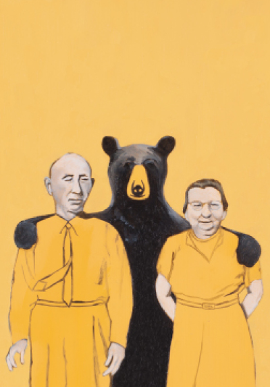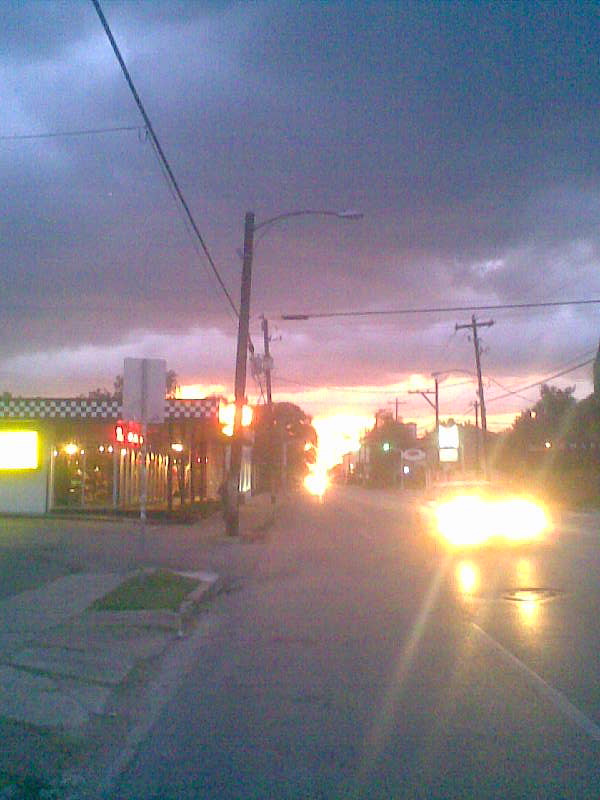The Five Books I’d Rescue From the Fire
I have favorite books. And then I have favorite books, as in, the objects themselves, the ones made weird and irreplaceable by the extra markings in or on them—the annotations, the inscriptions, the love notes.
When people ask for my “favorites,” this is the list I actually want to give.
Item #1:
Ken Kesey’s One Flew Over the Cuckoo’s Nest, inscribed to me with flying squirrel.
You might think this had something to do with my writing aspirations. You know, “Look out below, as you climb this crazy ladder!” But no. I just asked the guy to draw me a flying squirrel. And he did. It was 1998, and I was in college. I knew, dimly, that Kesey was important, so I went to his talk and waited in a long line, and when it was my turn he took the ring off my finger and did a magic trick with it. His speech had included a story about a flying squirrel, and I thought I’d take a chance. As he drew, I said, “I bought a new copy because the one back home is falling apart.” Of course there was no copy back home. In retrospect, I’m glad I didn’t fully understand who Ken Kesey was till a few years later. Because I would have peed myself.
Item #2:
Maurice Parmelee’s Nudism in Modern Life (modern being 1927), published by Knopf and smeared with what looks like blood. (But it can’t be, right? Because blood turns brown. Right?)
A seven dollar find at a used book store in Vermont. This guy argues so charmingly for the ways “gymnosophy” will end racism and war that I actually start to believe him. I’m with him all the way to the point where he argues nudity will save men from mating with imperfect women.
Okay, this one might not count as truly irreplaceable. But are those seven copies on Alibris also smeared with what might be blood? Probably not.
Item #3:
Christmas in America: A History, by Penne L. Restad. This is actually a fabulous book. I strongly recommend it. But it’s the inscription I’d be saving:
Augie-doggie Mr. S., I miss you and think of you often. Here’s something just for fun. Hope you enjoy it. I’ll be thinking of you all by a warm fire; with love, Joan.
A perfectly normal inscription, until you dissect it. Among the questions it raises:
1. What could her relationship be to this man, that she calls him both “Mr. S.” and a ridiculous nickname? Is he the history teacher she had an affair with? Her best friend’s chummy father? Or is the whole thing one nickname, the exact thing she’d shout if she saw him on the street in New York? “Hey, Augie-doggie Mr. S.! It’s me, Joan! The student you used to love!”
2. Why the mix of casual and intense? She thinks of him often, she misses him, she plans to think of him more; but hey, this is a little something just for fun. Maybe I’ve stared at the inscription too long, but I detect a yearning behind the casual pose, something tragic or unfulfilled. Poor Joan…
3. Who’s by the warm fire? Is she imagining of all of them sitting by the fire, or is she gloating that she’s got a fire, and she’s just thinking of them (All of them? Who are they all?) as she sits there?
4. Why would Augie-doggie Mr. S. give away the book? Someone wrote this lovely inscription, thought to send the book, and he gave it away. Did his wife throw it out in a jealous fit? Is Joan a stalker who sends him books every year? Did he have two copies, and the other bore a more meaningful inscription? Is he mad because Joan forgot he’s Jewish?
5. WAIT: Could Augie-doggie Mr. S. be Saul Bellow? I mean, think about it. It’s perfect.
Item #4:
Italo Calvino’s If On a Winter’s Night a Traveler, annotated by my brother-in-law.
… And then there are the marks made by the people we know. We liberated this from my in-laws’ house years ago, where my husband’s younger brother had abandoned it at some point during college.
I love that he plans to avoid both obfuscation and obfusceration, and I love that he has reproduced, with startling accuracy, the 17th hole of a golf course where, one presumes, he’d rather have been. And I love the par avion label. But even better is the fact that it’s a Calvino book, that these notes provide a fittingly weird outer envelope to a text that is, itself, a series of narrative envelopes.
You are about to begin playing Italo Calvino’s new golf course…
Item #5:
The Book Book.
Someone gave us this groovy hand-bound book for a wedding present. We couldn’t see ourselves asking people to sign it. I wasn’t about to fill it with crappy story drafts or start journaling. So we began writing down every book we read. (Jon gets the left page and I get the right. As you can tell, he’s a much faster reader.)
It’s made me more determined to finish things, in the same way my childhood library’s summer reading program once did.
It’s also the best diary I could have. If I want to remember December, 2003, I just need to see that I was reading Motherless Brooklyn and it all comes back: pneumonia, hospital, striped sweater, and the last time I ever played tennis.
And it’s also afforded me the greatest insult I could give a book. When a book is so extraordinarily bad that I’d be embarrassed to record it—terrified that my grandchildren, after I’m gone, might pick this one book off the list and read it to see what kind of person I was—I’ll refuse to write it down.
It’s a rare punishment, one I’ve only exercised a few times.
And therein lies the essay I’ll never write, a companion to this one: The Five Books I’d Consign to the Flames.


